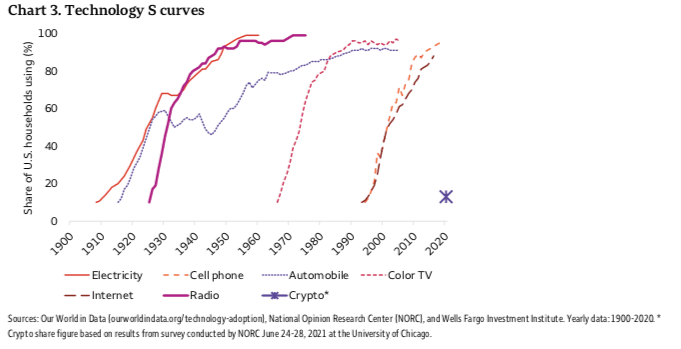We are at a moment of division in the crypto world. On one hand, there is an unprecedented institutional surge: Wall Street giants like BlackRock and Fidelity are embracing Bitcoin in ways never seen before, with their spot ETF products absorbing hundreds of billions of dollars (about $100 billion) of traditional capital; sovereign wealth funds and national pensions are also quietly incorporating crypto assets into their massive investment portfolios. This wave makes the narrative of 'cryptocurrency becoming mainstream' sound incredibly real.
On the other hand, for the general public, the crypto world seems more distant than ever. Apart from the violent price fluctuations and the stories of a few speculators, it has almost no presence in daily life. The once-boisterous NFT market has fallen silent, and the Web3 games that were once filled with high hopes have failed to 'break through'. This huge temperature difference creates a core contradiction: one side is a feast for financial elites, while the other side is the mainstream world's detached observation. How should we understand this disconnection?
In this context, senior executives at Visa, including its CEO Alfred F. Kelly Jr., have made a profound judgment on multiple occasions: cryptocurrencies are at a stage similar to 'early 1990s e-commerce'. Although not fully understood by the public, their underlying technologies and ecosystems are maturing rapidly, soon to encounter a 'super inflection point' in the adoption curve. Research from institutions like Wells Fargo provides data support for this analogy. Reports show that the user adoption curve for cryptocurrencies is surprisingly similar to that of the early 1990s internet. Although the internet was born in 1983, by 1995, less than 1% of the global population was using it. This digital proportion is strikingly similar to today’s cryptocurrency users. History shows that disruptive technologies go through a long, slow, and confusing ramp-up period before they explode.
 Image source: (MarsBit)
Image source: (MarsBit)
However, this seemingly perfect analogy may obscure a deeper truth. History does not simply repeat itself. The script for today's crypto world is being completely rewritten by two variables that were unimaginable back then—the entry of financial 'regular troops' and the rise of artificial intelligence (AI). This is not only a replay of history but also an accelerated and distinctly different evolution.
Giants of the old world, pioneers of the new continent
The e-commerce revolution of the 1990s was a typical 'disruptor' game. Back then, Amazon, eBay, and PayPal rose as 'new nobles' from the fringes of the mainstream business world, challenging traditional giants like Walmart and Citibank with entirely new rules. It was an era belonging to garage entrepreneurs and venture capitalists, with the main storyline centered around 'disruption' and 'replacement'.
And today, the story of cryptocurrencies presents a drastically different narrative. The most notable pioneers are no longer just hoodie-clad crypto punks but also the formally dressed financial 'regular troops' from Wall Street and Silicon Valley. They are not trying to destroy the old world but are attempting to 'transport' the entire old world onto the new technological foundation. This 'inside-out' transformation is vividly demonstrated in 2025.
Larry Fink, CEO of BlackRock, is accelerating the realization of his 'asset tokenization' prediction. After the success of the Bitcoin spot ETF in 2024, BlackRock partnered with Securitize to launch its first tokenized fund—BUIDL—on Ethereum, turning shares of traditional money market funds into tokens that can circulate 24/7 on the blockchain. At the same time, the number of companies (referred to as DATCOs) that hold crypto assets as strategic reserves has surged, with the total amount of crypto assets on their balance sheets historically exceeding $100 billion (about $100 billion).
A more critical variable comes from the change in attitude of the U.S. government. The previously ambiguous and sometimes hostile regulatory environment saw a decisive turnaround in 2025. The U.S. government not only became a significant holder of Bitcoin itself (by seizing nearly 200,000 Bitcoins through law enforcement), but more importantly, began to establish clear 'rules of the game' for the industry. The (GENIUS Act) signed in July is the first comprehensive federal regulatory framework for stablecoins in the U.S., providing a compliance path for this market valued at over $250 billion (about $250 billion). Following this, an executive order allowing $9 trillion (about $9 trillion) in U.S. pensions to invest in cryptocurrencies and other alternative assets opened a massive channel for incremental capital into the market. This top-down recognition fundamentally changed the risk-return calculations for institutional entry, solidifying the foundation for this transformation.
AI: The 'new species' seeking native economic soil
If the entry of financial giants paved the way for the crypto world to connect with the real world, then the explosion of artificial intelligence has brought the first true 'natives' to this new continent.
The internet of 1995 addressed the connection issues between 'people' and 'information', as well as 'people' and 'products'. The essence of e-commerce is to digitize and bring online the commercial activities of human society. The next era we are entering will be about how 'AI' collaborates economically with other 'AIs'. As a new productive force, AI is creating digital content, code, designs, and even scientific discoveries at an unprecedented speed. The value created by AI urgently needs a matching, native economic system.
Cryptographic technology is precisely designed for this purpose. Imagine a scenario: an AI design program autonomously creates a unique piece of art. It can mint this work into an NFT (non-fungible token) through a smart contract, thus gaining unique, verifiable ownership. Subsequently, another AI marketing program discovers this NFT and autonomously decides to pay a small amount of cryptocurrency to promote it on social media. If an AI purchasing agent for a clothing brand is interested in this design, it can directly interact with the smart contract holding the NFT, automatically paying a licensing fee to gain permission to produce 1,000 T-shirts. The entire process requires no human intervention, and the creation, rights confirmation, circulation, and distribution of value occur instantaneously on-chain.
This is not science fiction. Ethereum founder Vitalik has pointed out that the combination of AI and crypto can solve each other's core problems: AI needs trustworthy rules and asset ownership, while the crypto world needs a 'user' that can act autonomously. This symbiotic relationship is giving rise to entirely new application scenarios. For example, decentralized computing networks (like Akash Network) allow AI developers to rent idle global GPU computing power with cryptocurrency; while on-chain AI models attempt to build more transparent and censorship-resistant intelligent systems through token economics incentives.
This kind of AI-native economic activity may scale and speed far beyond the total of human commercial activities. What it needs is a global unified, low-friction, programmable value settlement layer. This is precisely the core value of crypto technology, and it is a grand vision that the internet of the 1990s could not reach.
Are we looking for the next 'Amazon' or 'TCP/IP'?
Faced with such changes, investors and builders often ask: who will be the 'Amazon' or 'Google' of the crypto world?
The question itself may be limited by historical experience. Amazon's success was built on the platform economic model of Web 2.0—a centralized company attracting massive users by providing excellent services, ultimately forming a winner-takes-all network effect. However, the spirit core of the crypto world lies in 'protocols' rather than 'platforms'. Its goal is to create public infrastructure that is open, neutral, and permissionless, much like TCP/IP (the underlying communication protocol of the internet).
Therefore, the future winners may not be a closed business empire, but an open ecosystem or a widely adopted underlying standard. What we may see is that a Layer 2 network (like Arbitrum or Optimism) becomes the actual carrying layer for the vast majority of applications due to its outstanding performance and developer ecosystem; or a cross-chain communication protocol (like LayerZero or Axelar) becomes the 'value router' connecting all blockchains; or a decentralized identity (DID) standard becomes the unified passport for all users to enter the digital world.
The winners at the 'protocol' layer will have business models that are fundamentally different from Amazon's. They will not profit by charging high platform fees but will capture the value of the entire ecosystem's growth through their native tokens. They are more like public utilities such as city roads and water supply systems, rather than a monopolistic supermarket.
Of course, this does not mean that the application layer has no opportunities. Great companies will still emerge on these open protocols. However, their key to success will no longer be about building closed moats but rather how to better utilize these open protocols to create unique value for users.
Finally, back to that quote: If you are willing to view the judgment of Visa's CEO as a signal rather than a resolution, then the more important question is 'how do we turn signals into practice'. For enterprises, this is a comprehensive project from strategic alignment, compliance preparation to product implementation; for individual and institutional investors, it is about clearly distinguishing long-term perspectives from short-term fluctuations, neither blindly following nor passively avoiding, and seeking on-chain applications that can create value in the real economy.
History provides us with two things: a mirror that allows us to see possible trajectories; and lessons that remind us that the ultimate winners are often not the fastest speculators but the infrastructures and platforms that establish lasting, real demand and can transcend cycles. Today's crypto is simultaneously writing two parts of a script—the lively short story of the market and the slowly emerging long story of infrastructure. If Visa's words are true, the next 10 years will be a crucial decade for the latter to accelerate into the mainstream.
This article is reprinted with permission from: (MarsBit)
Original title: (The '1995 Moment' of the Crypto World: History is Repeating, But the Script is Different)
Original author: Oliver, Mars Finance
'The crypto world welcomes the 1995 internet explosion! History is repeating, but the script is different.' This article was first published in 'Crypto City'.





